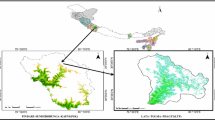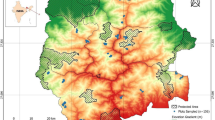Abstract
We conducted a study in Komto Forest in East Wollega Zone, Oromia National Regional State, West Ethiopia for determining vegetation structure and regeneration status in this forest. We systematically sampled 53 quadrats (20 m × 20 m) along line transects radiating from the peak of Komto Mountain in eight directions. Vegetation parameters such as DBH, height, seedling and sapling density of woody species, and location and altitude of each quadrat were recorded. In total, 103 woody plant species of 87 genera and 45 families were identified. Analysis of selected tree species revealed different population structures. Generally, the forest was dominated by small trees and shrubs characteristic of secondary regeneration. Observations on the regeneration of the forest indicated that there are woody species that require urgent conservation measures. Based on the results of this study, we recommend detailed ecological studies of various environmental factors such as soil type and properties, and ethnobotanical studies to explore indigenous knowledge on uses of plants.
Similar content being viewed by others
References
Ayalew A, Bekele T, Demissew S. 2006. The undifferentiated afromontane forest of Denkoro in the central highland of Ethiopia: a floristic and structural analysis. Ethiop J Sci, 29(1): 45–56.
Bekele T. 1993. Studies on remnant Afromontane forests on the central plateau of Shewa, Ethiopia. Acta Phytogeographica SuecicaPhytogeogr. Suec., 79: 1–58.
Bekele T. 1994. Phyosociology and Ecology of Humid Afromontane Forest on the Central plateau of Ethiopia. J Veg Sci, 5: 87–98.
Demissew S, Cribb P, Rasmussen F. 2004. Field Guide to Ethiopian Orchids (Kew Field guide). England: Royal Botanic Gardens, Compass press Ltd, p. 247.
Demissew S, Friis I. 2009. Natural vegetation of the Flora area. In: Hedberg, I., Friis, I. and Persson, E. (eds), Flora of Ethiopia and Eritra (Volume 8). Addis Ababa: The National Herbarium, Addis Ababa University, pp. 28–29.
Demissew S, Wondeafrash M, Dellellegn Y. 1996. Ethiopia’s Natural Base. In: Important Bird Areas of Ethiopia: A first Inventory. Addis Ababa, Ethiopia: Ethiopian Wildlife and Natural History Society, pp. 36–53.
Denu D. 2006. Floristic composition and eEcological Sstudy of Bibita Forest (Gura Ferda), Southwest Ethiopia, M.Sc. Thesis. Addis Ababa University.
EFAP. 1994. Ethiopian Forestry Action Program (Volume III). The Challenge for Development. Addis Ababa: Ministry of Natural Resources, p. 138.
EPA. 1998. National Action program to combat Desertification (Vol.1). Addis Ababa: Environmental Protection Authority. p. 158.
FAO. 1996. Ethiopia: Country report to the FAO International Technical conference on Plant Genetic Resource. Addis Abeba: Plant Genetic Resources Center, p. 90.
Friis I, Demissew S. 2001. Vegetation maps of Ethiopia and Eritrea. A review of existing maps and the need for a new map for the flora of Ethiopia and Eritrea. In: Friis, I. and Ryding, O. (eds), Biodiversity Research in the Horn of Africa Region. Copenhagen: Proceedings of the 3rd International symposium on the Flora of Ethiopia and Eritrea at the Crlsberg Academy, pp. 399–439.
Friis I, Rasmussen FN, Vollesen K. 1982. Studies in the flora and Vegetation of Southwest Ethiopia. Denmark: Institute of Systematic Botany, University of Copenhagen, p. 67.
Friis I. 1992. Forest and forest trees of northeast tropical Africa: their natural habitats and distribution pattern in Ethiopia, Djibouti and Somalia. Kew Bull Add Ser, 15: 1–396.
Hundera K, Bekele T, Kelbessa E. 2007. Floristic and Phytogeographic synopsis of a Dry Afromontane coniferous forest in the Bale Mountain (Ethiopia): Implication to biodiversity conservation. SINET: Ethiop J Sci, 30(1):1–12.
Kelbessa E, Demissew S, Woldu Z, Edwards S. 1992. Some threatened Endemic Plants of Ethiopia. In: Edwards S, Asfaw Z (eds.), The Status of Some Plants in Parts of Tropical Africa, Botany 2000: NAPREC, Monograph Series No.2. Ethiopia: Addis Ababa University; 1992: 35–55.
Kelbessa E, Soromessa T. 2008. Interfaces of regeneration, structure, diversity and uses of some plant species in Bonga Forest: A reservoir for wild coffee gene pool. SINET: Ethiop J Sci, 31(2): 121–134.
Kent M, Coker P. 1992. Vegetation Description and Analysis: A practical approach. New York: John Wiley and Sons, p. 363.
KiKitessa H, Tsegaye G. 2008. Woody species composition and structure of the Belete Forest, Jimma Zone, SW Ethiopia, Ethiopian journal of the Biological sciences, 7(1): 1–15.
Lisanework N, Mesfin T. 1989. An Ecological study of the vegetation of the Harenna forest, Bale, Ethiopia. SINET: Ethiop J Sci, 12: 63–93.
Logan WEM. 1946. An Introduction to the Forests of Central and Southern Ethiopia. Oxford: Imperial Forest Institute, p. 38.
Lulekal E, Kelbessa E, Bekele T, Yineger Y. 2008. Plant species composition and structure of the Mana Angetu moist montane forest, Southeastern Ethiopia. J E Afri Nat Hist, 97(2): 165–185.
Muller-Dombois D, Ellenberg H. 1974. Aims and Methods of Vegetation Ecology. New York: Wiley and Sons, p. 547.
NBSAP. 2005. National Biodiversity Strategy and Action Plan. Addis Ababa: Institute of Biodiversity Conservation, p. 103.
R-Development Core Team. 2007. A language and environment for statistical computing. Austria: R Foundation for Statistical Computing. p. 253
Senbeta F, Teketay D. 2003. Diversity, community types and population structure of woody plants in Kimphe Forest, a virgin Nature Reserve in Southern Ethiopia. Ethiop J Biol Sci, 2(2): 169–187.
Senbeta F, Woldemariam T, Demissew S, Denich M. 2007. Floristic diversity and composition of Sheko Forest, Southwest Ethiopia. Ethiop J Biol Sci, 6(1): 11–32.
Senbeta F, Denich M. 2006. Effects of wild coffee management on species diversity in the Afromontane rainforests of Ethiopia. Forest Ecology and Management, 232: 68–74.
Shibru S, Balcha G. 2004. Composition, structure and regeneration status of woody species in Dindin Natural Forest, Southeast Ethiopia: An implication for conservation. Ethiop J Biol Sci, 3(1): 15–35.
Teketay D. 2001. Deforestation, wood famine, and environmental degradation in Ethiopia’s highland ecosystems: urgent need for action. Northeast African Studies, 8(1): 53–76.
Teketay D. 2005. Seed and regeneration ecology in dry Afromontane forests of Ethiopia: I. Seed production — population structures. Tropical Ecology, 46(1): p. 29–44.
USAID. 2008. Ethiopian Biodiversity and Tropical forest 118/119 Assessment. EPIQ IQC: EPP-I-00-03-00014-00, Task Order 02.
Woldeyohannes E. 2008. Floristic analysis of Alata-Bolale Forest in Gudaya Billa Woreda, East Wollega, Oromia Regional State, West Ethiopia (M.Sc. Thesis). Ethiopia: Addis Ababa University.
Woldu Z. 2008. The Population, Health and Environment Nexus. Ethiopia: Addis Ababa University, p. 34.
Yeshitela K, Bekele T. 2002. Plant community analysis and ecology of Afromontane and transitional rainforest vegetation of southwestern Ethiopia. SINET: Ethiop J Sci, 25(2):155–175.
Yeshitela K, Bekele T. 2003. The woody species composition and structure of Masha Anderacha forest, Southwestern Ethiopia. Ethiop J Biol Sci, 2(1): 31–48.
Zerihun W, Feoli E, NigatuLisanework NL. 1989. Partitioning an elevation gradient of vegetation from southeastern Ethiopia by probabilistic methods. Vegetatio, 81: 189–198.
Author information
Authors and Affiliations
Corresponding author
Rights and permissions
About this article
Cite this article
Gurmessa, F., Soromessa, T. & Kelbessa, E. Structure and regeneration status of Komto Afromontane moist forest, East Wollega Zone, west Ethiopia. Journal of Forestry Research 23, 205–216 (2012). https://doi.org/10.1007/s11676-012-0242-8
Received:
Accepted:
Published:
Issue Date:
DOI: https://doi.org/10.1007/s11676-012-0242-8




